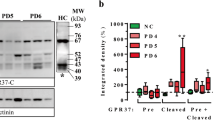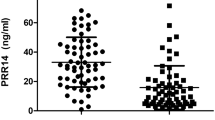Abstract
Prolyl oligopeptidase (also named prolyl endopeptidase; PREP) hydrolyzes the Pro-Xaa bonds of biologically active oligopeptides on their carboxyl side. In 1987, we detected PREP activity in human cerebrospinal fluid (CSF) using highly sensitive liquid chromatography–fluorometry with succinyl-Gly-Pro-4-methyl-coumarin amide as a new synthetic substrate, and found a marked decrease in its activity in the cerebrospinal fluid (CSF) from patients with Parkinson’s disease (PD) as compared with its level in control patients without neurological diseases. In 2013, Hannula et al. found co-localization of PREP with α-synuclein in the postmortem PD brain. Several recent studies also suggest that the level of PREP in the brain of PD patients may be related to dopamine (DA) cell death via promotion of α-synuclein oligomerization and that inhibitors of PREP may play a neuroprotective role in PD. Although the relationship between another family of prolyl oligopeptidase enzymes, dipeptidyl peptidase II (DPP II) and dipeptidyl peptidase IV (DPP IV), and α-synuclein in the PD brain is not yet clear, we found that the DPP II activity/DPP IV activity ratio in the CSF was significantly increased in PD patients. This review discusses the possibility of PREP as well as the DPP II/DPP IV ratio in the CSF as potential biomarkers of PD.
Similar content being viewed by others
References
Abbott CA, Baker E, Sutherland GR, McCaughan GW (1994) Genomic organization, exact localization, and tissue expression of the human CD26 (dipeptidyl peptidase IV) gene. Immunogenetics 40:331–338
Agirregoitia N, Casis L, Gil J, Ruiz F, Irazusta J (2007) Ontogeny of prolyl endopeptidase and pyroglutamyl peptidase in rat tissues. Regul Pept 139:52–58
Barrett AJ, Rawlings ND (1992) Oligopeptidases, and the emergence of the prolyl endopeptidase family. Biol Chem Hoppe-Seyler 373:353–360
Brandt I, Gerard M, Sergeant K, Devreese B, Baekelandt V, Augustyns K, Scharpe S, Engelborghs Y, Lambeir AM (2008) Prolyl oligopeptidase stimulates the aggregation of alpha-synuclein. Peptides 29:1472–1478
Breen G, Harwood AJ, Gregory K, Sinclair M, Collier D, St Clair D, Williams RS (2004) Two peptidase activities decrease in treated bipolar disorder not schizophrenic patients. Bipolar Disord 6:156–161
Eisenhauer DA, McDonald JK (1986) A novel dipeptidyl peptidase II from the porcine ovary. Purification and characterization of a lysosomal serine protease showing enhanced specificity for prolyl bonds. J Biol Chem 261:8859–8865
Fukasawa KM, Fukasawa K, Higaki K, Shiina N, Ohno M, Ito S, Otogoto J, Ota N (2001) Cloning and functional expression of rat kidney dipeptidyl peptidase II. Biochem J 353:283–290
Fuse Y, Polk DH, Lam RW, Reviczky AL, Fisher DA (1990) Distribution and ontogeny of thyrotropin-releasing hormone degrading enzymes in rats. Am J Physiol 259(6 Pt 1):E787–E791
Goossens FJ, Wauters JG, Vanhoof GC, Bossuyt PJ, Schatteman KA, Loens K, Scharpé SL (1996) Subregional mapping of the human lymphocyte prolyl oligopeptidase gene (PREP) to human chromosome 6p22. Cytogen Cell Genet 74:99–101
Gorenstein C, Tran VT, Snyder SH (1981) Brain peptidase with a unique neuronal localization: the histichemical distribution of dipeptidyl-aminopeptidase II. J Neurosci 1:1096–1102
Hagihara M, Nagatsu T (1987) Post-proline cleaving enzyme in human cerebrospinal fluid from control patients and parkinsonian patients. Biochem Med Metab Biol 38:387–391
Hagihara M, Mihara R, Togari A, Nagatsu T (1987) Dipeptidyl aminopeptidase II in human cerebrospinal fluid: changes in control patients and parkinsonian patients. Biochem Med Metabol Biol 37:360–365
Hannula MJ, Myöhänen TT, Tenorio-Laranga J, Männistö PT, Garcia-Horsman JA (2013) Prolyl oligopeptidase colocalizes with α-synuclein, β-amyloid, tau protein and astroglia in the post-mortem brain samples with Parkinson’s and Alzheimer’s diseases. Neuroscience 242:140–150 (Erratum in Neuroscience 248:344)
Holst JJ, Deacon CF (1998) Inhibition of dipeptidyl-peptidase IV as a treatment for type 2 diabetes. Diabetes 47:1663–1670
Hopps-Have VK, Glenner GG (1966) A new dipeptide naphtylamidase hydrolyzing glycyl-prolyl-beta-naphtylamide. Histochemie 7:197–201
Jellinger KA (2012) CSF biomarkers in different phenotypes of Parkinson disease. J Neural Transm 119:455–456
Kato T, Nagatsu T, Kimura T, Sakakibara S (1978) Fluorescence assay of X-prolyl aminopeptidase activity with a new fluorogenic substrate. Biochem Med 19:351–359
Kato T, Okada M, Nagatsu T (1980a) Distribution of post-proline cleaving enzymes in human brain and the peripheral tissues. Mol Cell Biochem 32:117–121
Kato T, Nakano T, Kojima K, Nagatsu T, Sakakibara S (1980b) Changes in prolyl endopeptidase during maturation of rat brain and hydrolysis of substance P by the purified enzyme. J Neurochem 35:527–535
Kojima K, Mihara R, Sakai T, Togari A, Matsui T, Shinpo K, Fujita K, Fukasawa K, Harada M, Nagatsu T (1987) Serum activities of dipeptidyl-aminopeptidases IV in tumor-bearing animals and in cancer patients. Biochem Med Metab Biol 37:35–41
Matteucci E, Giampietro O (2015) Mechanisms of neurodegeneration in type 2 diabetes and the neuroprotective potential of dipeptidyl peptidase 4 inhibitors. Curr Med Chem 22:1573–1581
McDonald JK (1998) Dipeptidyl-peptidase II. In: Barrett AJ, Rawlings ND, Woessner JF (eds) Handbook of proteolytic enzymes. Academic Press, San Diego, pp 372–374
McDonald JK, Leibach FH, Grindeland RE, Ellis S (1966) Purification of dipeptidyl aminopepidase II (dipeptidyl arylamidase II) of the anterior pituitary gland. Properties and dipeptide esterase activities. J Biol Chem 243:4143–4150
Mentlein R, Struckhoff G (1989) Purification of two dipeptidyl peptidase II from rat brain and their action on proline-containing neuropeptides. J Neurochem 52:1284–1293
Mentlein R, Galwitz B, Schmidt WE (1993) Dipeptidyl-peptidase IV hydrolyzes gastric inhibitory polypeptide, glucagone-like peptide-1(7-36)amide, peptide histidine methionine and is responsible for their degradation in human serum. Eur J Biochem 214:829–835
Misui Y, Ikehara Y (1998) Prolyl oligopeptidase. In: Barrett AJ, Rawlings ND, Woessner JF (eds) Handbook of Proteolytic Enzymes. Academic Press, San Diego, pp 372–374
Misumi Y, Hayashi Y, Arakawa F, Ikehara Y (1992) Molecular cloning and sequence analysis of human dipeptidyl peptidase IV, a serine proteinase on the cell surface. Biochem Biophys Acta 1131:333–336
Mogi M, Harada M, Kojima K, Inagaki H, Kondo T, Narabayashi H, Arai T, Teradaira R, Fujita K, Kiuchi K, Nagatsu T (1988a) Sandwich enzyme immunoassay of dopamine- beta-hydroxylase in cerebrospinal fluid from controls and parkinsonian patients. Neurochem Int 12:187–191
Mogi M, Harada M, Kiuchi K, Kojima K, Kondo T, Narabayashi H, Rausch D, Riederer P, Jellinger K, Nagatsu T (1988b) Homospecific activity (activity per enzyme protein) of tyrosine hydroxylase increases in parkinonian brain. J Neural Transm 72:77–82
Mogi M, Harada M, Kojima K, Adachi T, Narabayashi H, Fujita K, Naoi M, Nagatsu T (1989) β2-Microglobulin decreases in cerebrospinal fluid from parkinsonian patients. Neurosci Lett 104:241–246
Mogi M, Harada M, Kondo T, Riederer P, Nagatsu T (1995) Brain beta-2microglobulin levels are elevated in the striatum in Parkinson’s disease. J Neural Transm Park Dis Dement Sect 9:87–92
Myöhänen TT, Venäläinen JI, Garcia-Horsman JA, Piltonen M, Männistö PT (2008) Cellular and subcellular distribution of rat brain prolyl oligopeptidase and its association with specific neuronal neurotransmitters. J Comp Neurol 507:1694–1708
Myöhänen TT, Hannula MJ, Van Elzen R, Gerard M, Van Der Veken P, García-Horsman JA, Baekelandt V, Männistö PT, Lambeir AM (2012) A prolyl oligopeptidase inhibitor, KYP-2047, reduces alpha-synuclein protein levels and aggregates in cellular and animal models of Parkinson’s disease. Brit J Pharmacol 166:1097–1113
Nagatsu T, Hino M, Fuyamada H, Hayakwa T, Sakakibara S (1976) New chromogenic substrates for X-prolyl dipeptidyl-aminopepptidase. Anal Chem 74:466–476
Nagatsu T, Sakai T, Kojima K, Araki E, Sakakibara S, Fukasawa K, Harada M (1985) A sensitive and specific assay for dipeptidyl-aminopeptidase II in serum and tissues by liquid chromatography-fluorometry. Anal Biochem 147:80–85
Nakashima A, Ota A, Kaneko Y, Mori K, Nagasaki H, Nagatsu T (2013) A possible pathophysiological role of tyrosine hydroxylase in Parkinson’s disease suggested by postmortem brain biochemistry: a contribution for the special 70th birthday symposium in honor of Prof. Peter Riederer. J Neural Transm 120:49–54
Nausch I, Heymann E (1985) Substance P in human plasma is degraded by dipeptidyl peptidase IV, not by choline esterase. J Neurochem 44:1354–1357
Ogata S, Misumi Y, Ikehara Y (1989) Primary structure of rat liver dipeptidyl peptidase IV deduced from its cDNA and identification of the NH2-terminal signal sequence as the membrane-anchoring domain. J Biol Chem 264:3596–3601
Oya H, Harada M, Nagatsu T (1974) Peptidase activity of glycylprolyl beta-naphtylamidase from human submaxillary gland. Arch Oral Biol 19:489–491
Palalau AJ, Tahrani AA, Piya MK, Barnett AH (2009) DPP-4 inhibitors in clinical practice. Postgrad Med 121:70–100
Pauly RP, Rosche F, Wermann M, McIntosh CH, Pederson RA, Demuth HU (1995) Investigation of glucose-dependent insulinotropic polypeptide-(1-42) and glucagon-like peptide-1-(7-36) degradation in vitro by dipeptidyl peptidase IV using matrix-assisted laser desorption/ionization-time of flight mass spectrometry. A novel kinetic approach. J Biol Chem 271:23222–23229
Reinhold D, Bank U, Bühling F, Kähne T, Kunt D, Faust J, Neubert K, Ansorge S (1994) Inhibitors of dipeptidyl peptidase IV (DPP IV, CD26) specifically suppress proliferation and modulate cytokine production of strongly CD26 expressing U937 cells. Immunobiology 192:121–136
Savolainen MH, Yan X, Myöhänen TT, Huttunen HJ (2015) Prolyl oligopeptidase enhances α-synuclein dimerization via direct protein-protein interaction. J Biol Chem 290:5117–5126
Shirasawa Y, Osawa T, Hirashima A (1994) Molecular cloning and characterization of prolyl endopeptidase from human T cells. J Biochem 115:724–729
Vanhoof G, Goossens F, Hendriks L, De Meester I, Hendriks D, Vriend G, Van Broeckhoven C, Shrpé S (1994) Cloning and sequence analysis of the gene encoding human lymphocyte prolyl endopeptidase. Gene 149:363–366
Walter R, Shlank H, Glass JD, Schwarz IL, Kerenyi TD (1971) Leucylglycineamide released from oxytosin by human uterine enzyme. Science 173:827–829
Wang Q, Chu CH, Qian L, Chen SH, Wilson B, Oyarzabal E, Jiang L, Ali S, Robinson B, Kim HC, Hong JS (2014) Substance P exacerbates dopaminergic neurodegeneration through neurokinin-1 receptor-independent activation of microglial NADPH oxidase. J Neurosci 34:12490–12503
Yoshimoto T, Ito K (1998) Prolyl oligopeptidase. In: Barrett AJ, Rawlings ND, Woessner JF (eds) Handbook of Proteolytic Enzymes. Academic Press, San Diego, pp 372–374
Yoshimoto T, Orlowski RC, Walter R (1977) Post-proline cleaving enzyme: identification as serine protease using active site specific inhibitors. Biochemistry 16:2942–2948
Acknowledgments
We would like to thank Prof. Kurt Jellinger for providing samples from his brain bank during our collaboration on the biochemistry of the post mortem brain in Parkinson’s disease with Prof. Peter Riederer. Prof. Jellinger has made great contributions to the pathophysiology of neurodegenerative diseases, such as Parkinson’s and Alzheimer’s diseases, mainly by the histochemical approach with over 800 publications. One significant achievement in our collaboration with Prof. Peter Riederer and Prof. Kurt Jellinger on the biochemical analysis of dopamine-synthesizing enzymes in postmortem brain samples from parkinsonian patients was the finding that the homo-specific activity (activity per enzyme protein) of tyrosine hydroxylase, the regulatory enzyme of dopamine synthesis, is increased specifically in the substantia nigra (Mogi et al. 1988b). This work led us to another new study on phosphorylation, stability, and degradation of tyrosine hydroxylase in the brain (Nakashima et al. 2013). We dedicate this review to Prof. Kurt Jellinger on the occasion of his 85th birthday.
Author information
Authors and Affiliations
Corresponding author
Additional information
Special Issue on the occasion of the 85th birthday of Prof. Kurt A. Jellinger.
Rights and permissions
About this article
Cite this article
Nagatsu, T. Prolyl oligopeptidase and dipeptidyl peptidase II/dipeptidyl peptidase IV ratio in the cerebrospinal fluid in Parkinson’s disease: historical overview and future prospects. J Neural Transm 124, 739–744 (2017). https://doi.org/10.1007/s00702-016-1604-8
Received:
Accepted:
Published:
Issue Date:
DOI: https://doi.org/10.1007/s00702-016-1604-8




